Top 10 Feather Alternatives for Blogging in 2025
Feather is a fantastic choice for Notion-first publishing - simple, clean, and fast. But many teams outgrow its scope. If you need more customization, deeper SEO controls, richer analytics, or a different pricing and hosting model, it’s smart to compare a few Feather alternatives before you commit.
What you’ll find here:
10 simple, fast, SEO-friendly alternatives well-suited to creators, SaaS teams, and startups - spanning Notion-powered sites, traditional CMS options, and modern headless stacks.
Picks that prioritize search visibility, load speed, and workflow simplicity so you can publish more and rank better - without juggling plugins or custom code.
How to use this guide:
Skim the “Best for” notes to quickly match each platform to your goals (traffic growth, monetization, scale, or design control).
Check the Quick Specs table in each section for hosting model, pricing tier, SEO features, and notable limitations - so you can shortlist in minutes.
Keep your must-haves handy (e.g., multi-author workflows, AI-assisted publishing, built-in newsletters) and filter options fast.
At BlogBowl, we’ve helped hundreds of SaaS and startup teams launch content engines quickly. This guide distills what matters most in 2025: speed, SEO, and a workflow that won’t slow you down as you scale.
1) BlogBowl - AI‑automated, SEO‑first blogging that runs on autopilot
Ship a production‑ready blog, changelog, or help center in under a minute - then let automation do the heavy lifting. BlogBowl delivers daily SEO‑optimized posts, keyword research, internal linking, images, and embedded videos so your team can focus on strategy, not setup.
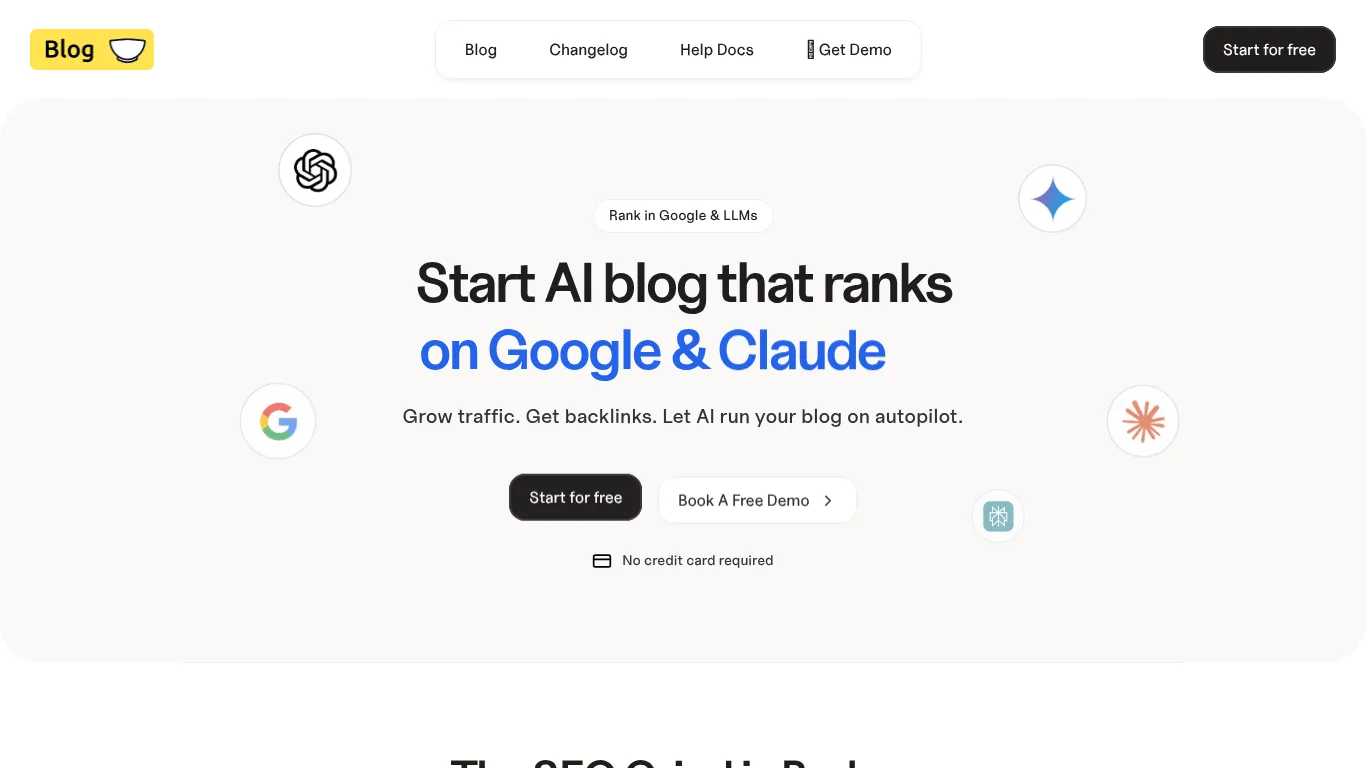
Overview
All‑in‑one hosted platform to launch blogs, changelogs, and help centers in under 60 seconds.
Heavy AI automation: daily SEO‑optimized posts, keyword research, internal linking, images, and embedded videos - all auto‑published.
Standout features
Fast, SEO‑optimized templates built to rank on Google and AI search tools.
Unlimited blogs, built‑in analytics, integrated newsletter, and multi‑author support.
Automatic internal linking and backlink exchange to grow traffic (backlink exchange rolling out).
Where it falls short
Best for teams that want automation over deep code‑level control.
Best for
SaaS teams and startups that want consistent, search‑ready content with minimal manual work - an ideal pick among Feather alternatives and today’s best blogging platforms for simple blogs at scale.
Quick Specs
Feature | Details |
|---|---|
Hosting model | Fully hosted SaaS with fast, SEO‑ready templates |
Setup time | Under 60 seconds from signup to live blog |
Content automation | Daily AI‑written, SEO‑optimized posts; keyword research; internal linking; AI images; embedded videos; auto‑publishing |
SEO | Templates tuned for Google and LLM visibility; on‑page optimizations and smart internal linking |
Performance | Lightning‑fast rendering designed for rankings and engagement |
Customization | No‑code controls for colors, fonts, and layouts |
Multi‑site | Unlimited blogs, changelogs, and help docs in one account |
Collaboration | Multi‑author support with streamlined publishing workflows |
Newsletter | Integrated email collection and newsletter tools |
Analytics | Built‑in, privacy‑friendly analytics and content insights |
Domains | Flexible custom domain integration (root or subfolder) |
Integrations | Works with no‑code tools; auto‑embeds media |
Growth | Automatic internal linking and backlink exchange (coming soon) |
Ideal users | SaaS, startups, and product teams prioritizing SEO and scale with minimal overhead |
Limitation | Less code‑level control than self‑hosted CMS options |
Getting started tip
Connect your domain, pick a template, seed your topic list/keywords, and let BlogBowl schedule your first batch of AI‑optimized posts.
2) Ghost - Minimal, fast, and membership‑ready
Ghost delivers a clean, open‑source CMS with a distraction‑free editor and native tools to turn readers into members. It’s built for speed, SEO, and sustainable audience growth with built‑in newsletters and paid subscriptions.
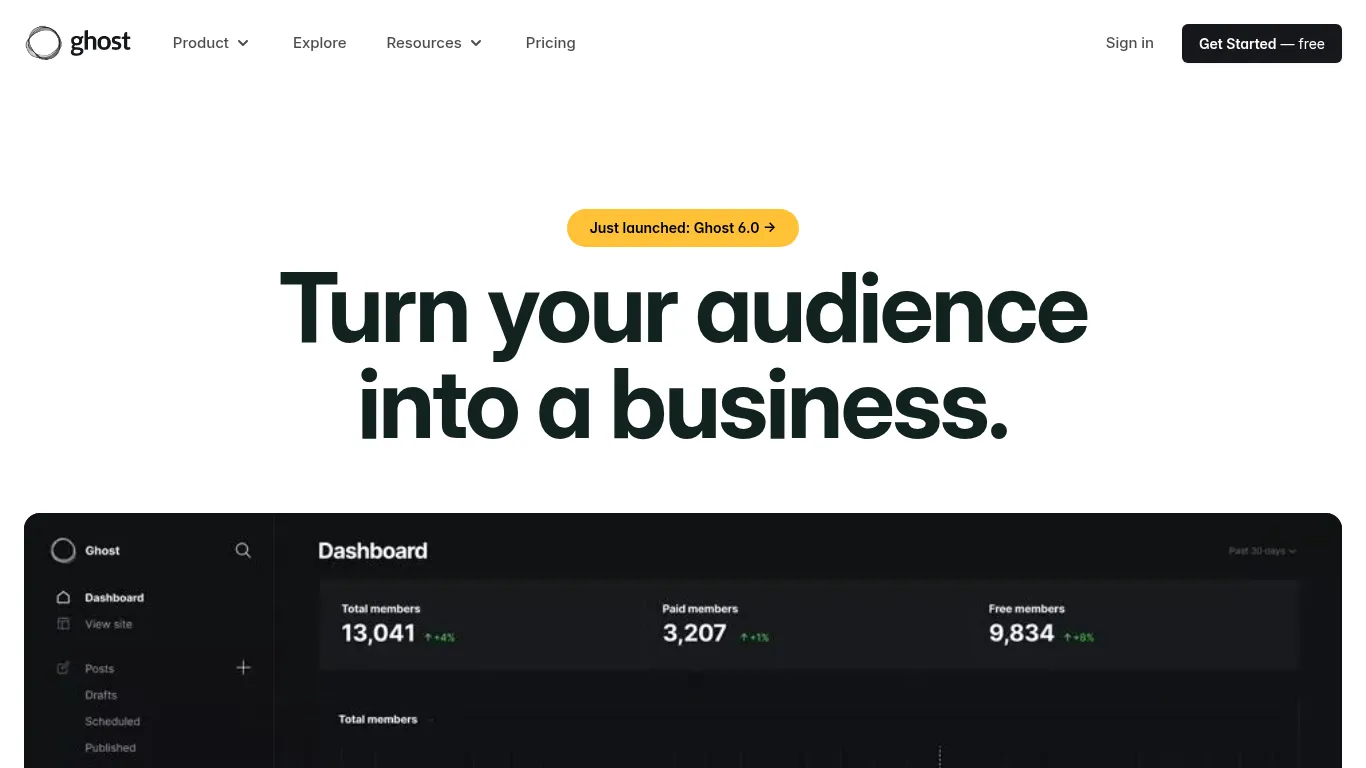
Overview
Open‑source CMS with clean writing experience and built‑in newsletters/memberships.
Standout features
Speedy publishing, SEO‑friendly themes, native paywalls and email.
Where it falls short
Less plugin variety than WordPress; deeper customization often needs dev help.
Best for
Writers and media startups building subscriber revenue on a clean, focused stack.
Quick Specs
Feature | Details |
|---|---|
Hosting model | Hosted (Ghost(Pro)) or self‑hosted open source |
Setup time | Minutes with hosted; longer for custom self‑hosting |
Monetization | Native memberships, paid subscriptions, 0% payment fees |
Built‑in newsletters and audience management | |
SEO | Clean themes, canonical/metadata controls, fast performance |
Themes | Modern, minimal templates geared for readability |
Analytics | Built‑in audience analytics; supports external tools |
Customization | Theme edits, custom routes; deeper work may need devs |
Community | Active ecosystem; smaller plugin library than WordPress |
Ideal users | Writers, creators, and media brands prioritizing memberships |
Getting started tip
Start hosted Ghost for simplicity; move to self‑hosted if you need more control later.
3) WordPress.org - Ultimate flexibility and scale
WordPress.org is the go‑to choice when you need complete control: custom workflows, granular SEO, and integrations for virtually anything. With a vast theme and plugin ecosystem, it scales from blogs to complex, content‑heavy properties.
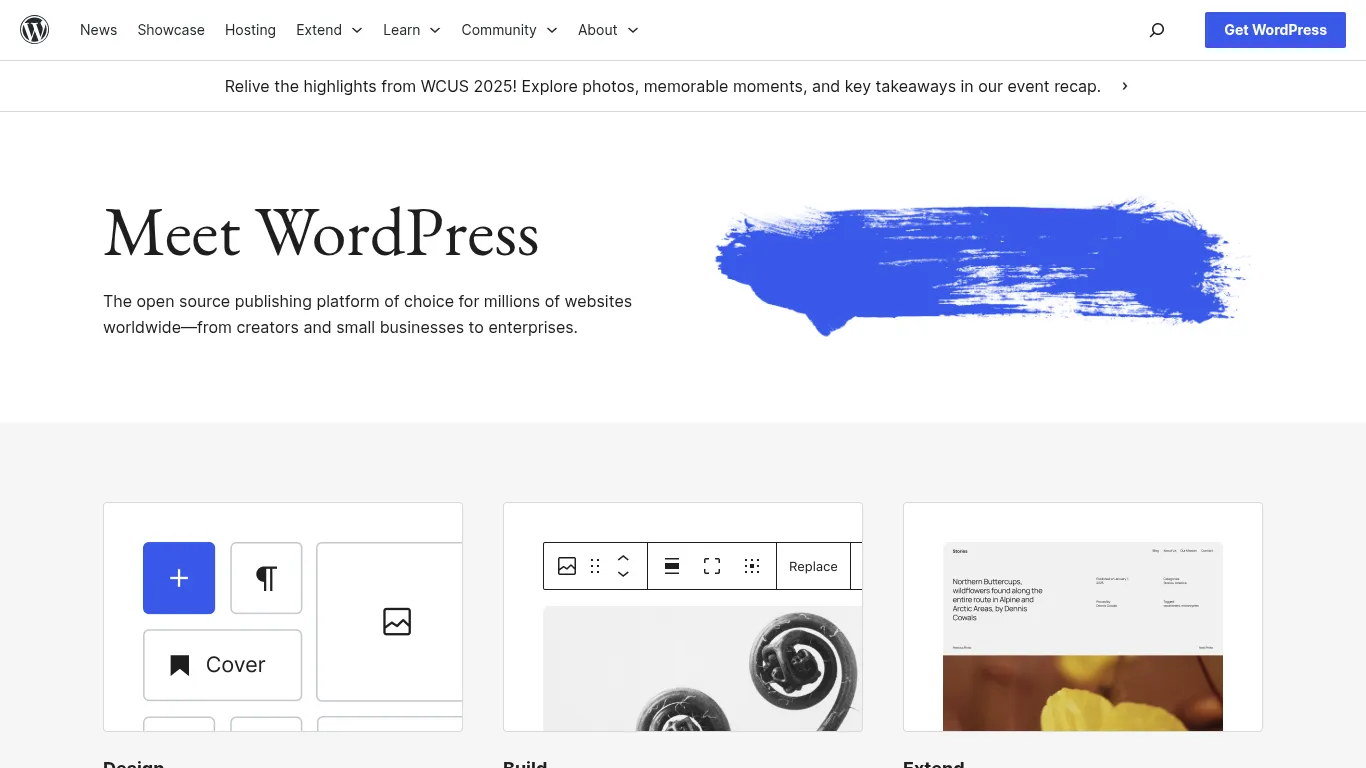
Overview
The most extensible CMS with massive theme/plugin ecosystem and enterprise‑grade scalability.
Standout features
60k+ plugins, full control of SEO, schema, performance, and complex content models.
Where it falls short
Requires hosting, maintenance, and more hands‑on setup.
Best for
Content‑heavy sites that need custom workflows, advanced SEO, and integrations.
Quick Specs
Feature | Details |
|---|---|
Hosting model | Self‑hosted CMS with full server control |
Setup time | Ranges from quick managed installs to custom builds |
Plugins & themes | 60k+ plugins; thousands of themes and builders |
SEO | Complete control over metadata, schema, redirects, sitemaps |
Performance | Tunable via caching/CDN, image optimization, headless |
Customization | Unlimited code‑level control; supports custom post types and fields |
Editorial workflow | Roles, revisions, scheduling; extensible via plugins |
Monetization | Ads, memberships, ecommerce via plugins |
Analytics | Native stats or connect GA4 and other BI tools |
Ideal users | Teams needing advanced SEO, integrations, and scale |
"As of 2025, WordPress powers about 43.4% of all websites and 61.3% of sites using a CMS." - Source
Getting started tip
Pair with reputable managed WordPress hosting and an SEO plugin to keep performance tight.
4) Webflow CMS - Pixel‑perfect design with solid SEO
Webflow pairs a visual, no‑code builder with a flexible CMS so designers can craft bespoke layouts while marketers safely manage content. The result: clean HTML/CSS, fast hosting, and SEO‑ready pages without lengthy dev cycles.
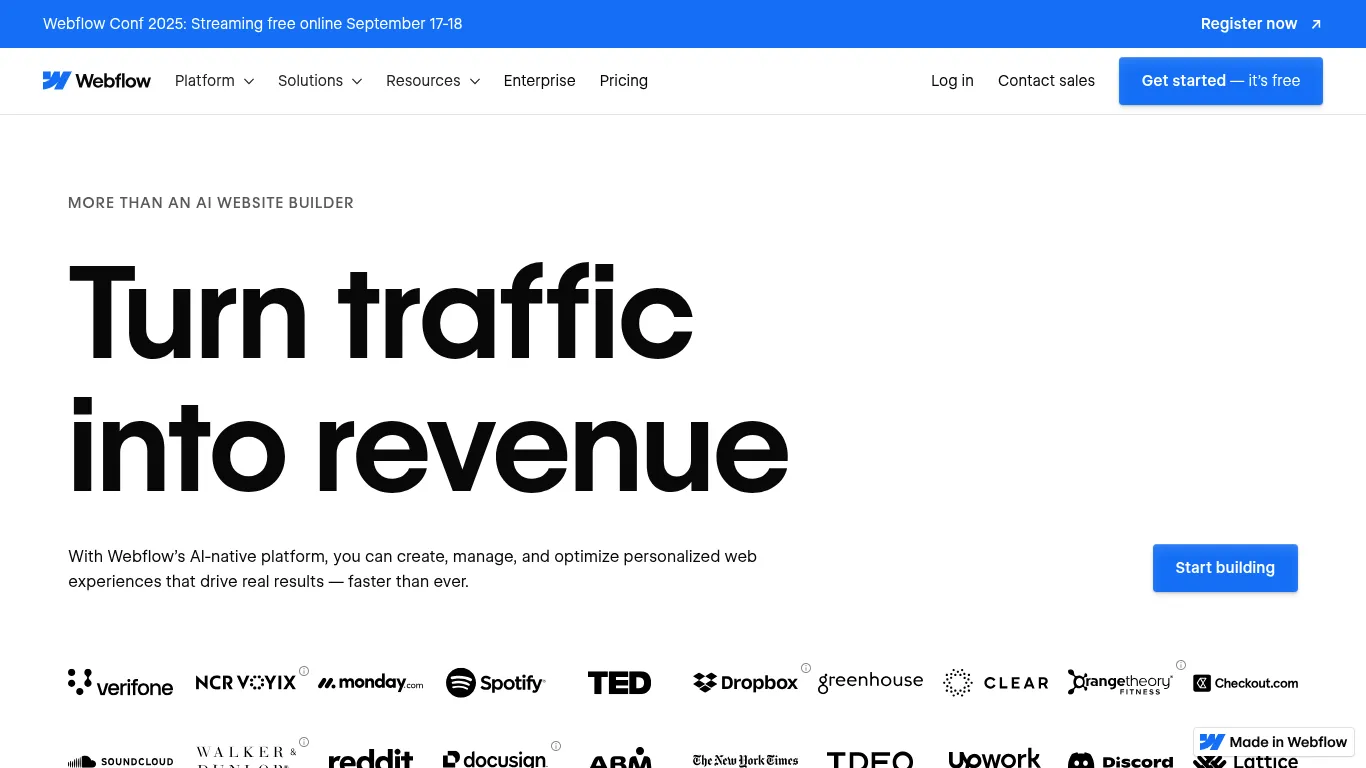
Overview
Visual, no‑code site builder with CMS collections and fine‑grained control of layout and SEO.
Standout features
Designer‑grade visuals, clean HTML/CSS, fast hosting, and CMS that marketers can edit safely.
Where it falls short
Learning curve; complex relationships vs. traditional/headless CMS are more limited.
Best for
Brands that need bespoke design and blog performance without heavy dev cycles.
Quick Specs
Feature | Details |
|---|---|
Hosting model | Fully hosted with global CDN and enterprise options |
Setup time | Fast with CMS‑ready templates; more time for custom builds |
CMS | Visual Collections for posts, categories, authors; headless APIs available |
SEO | Custom meta fields, canonical tags, clean markup, fast render |
Performance | High‑performance hosting; image/CDN optimization |
Design | Pixel‑perfect visual editor; componentized building blocks |
Collaboration | Roles, publishing workflows, design approvals |
Integrations | APIs, native integrations, app ecosystem |
Analytics & testing | Built‑in A/B testing, analytics, personalization options |
Ideal users | Design‑driven brands and growth teams needing speed + control |
Getting started tip
Use a CMS‑ready template and define Collections (posts, categories, authors) before building pages.
5) Wix - Quick launch with built‑in AI tools
Wix streamlines setup with polished templates, a drag‑and‑drop editor, and expanding AI tools for site structure, copy, and SEO - so you can publish fast and iterate often.
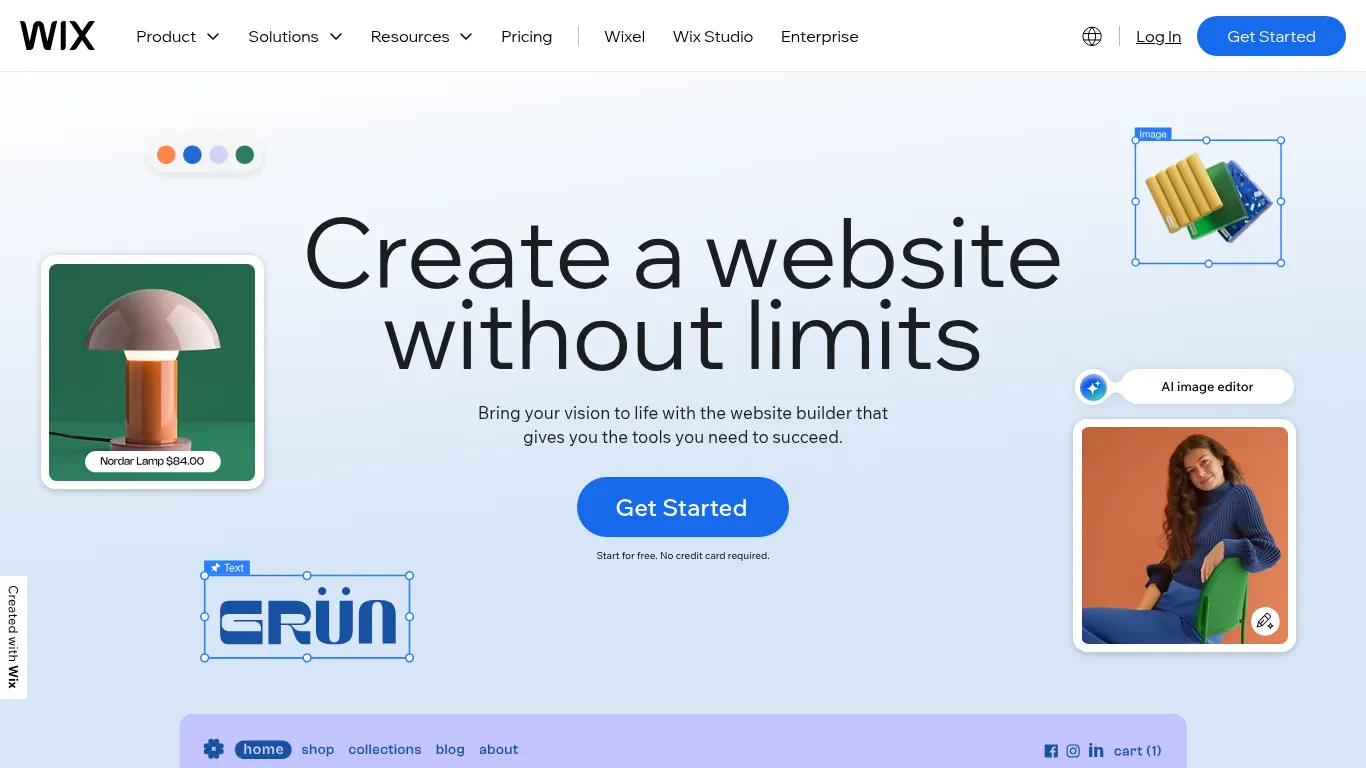
Overview
Hosted website builder with easy templates, blogging, and AI writing/SEO helpers.
Standout features
Rapid setup, monetization features, and growing AI assistance for content and structure.
Where it falls short
Less portable; advanced customization and migrations are more constrained.
Best for
Small businesses and solo creators who want to move fast without touching code.
Quick Specs
Feature | Details |
|---|---|
Hosting model | Fully hosted with global CDN and 99.99% uptime |
Setup time | Minutes with AI site builder or 900+ templates |
Blogging | Built‑in blog app with categories, tags, scheduling, and comments |
SEO | AI‑assisted metadata, structured data options, instant indexing, Search Console integration |
AI tools | Generate site sections, copy, images, layouts, and email campaigns |
Monetization | Subscriptions, paywalls, ecommerce, ads integrations |
Marketing | Social posting, ad campaigns, email marketing, CRM |
Performance | Optimized infrastructure with caching and image/CDN optimization |
Customization | Drag‑and‑drop editor; advanced code options via Velo if needed |
Ideal users | Creators and SMBs prioritizing speed to launch and built‑in growth tools |
Getting started tip
Pick a blog template, enable the blog app, and use AI tools to draft outlines/titles first.
6) Squarespace - Gorgeous templates, simple publishing
Squarespace combines premium templates with an intuitive editor and integrated marketing tools, making it easy to publish polished blogs and grow a brand without complex setup.

Overview
All‑in‑one site builder known for premium design and straightforward editing.
Standout features
Polished blog layouts, built‑in email marketing, and commerce add‑ons.
Where it falls short
Fewer advanced SEO levers; heavier media pages may load slower.
Best for
Creative brands prioritizing aesthetics and a clean, consistent editorial look.
Quick Specs
Feature | Details |
|---|---|
Hosting model | Fully hosted, all‑in‑one platform |
Setup time | Quick start with designer templates or AI‑assisted theme generation |
Blogging | Rich post layouts, categories/tags, scheduling, comments |
SEO | Built‑in basics; per‑post meta controls; integrations for social |
Design | High‑end templates and drag‑and‑drop editor |
Marketing | Native email campaigns that pull in posts and styles |
Commerce | Add‑on store, memberships, and simple paywalls |
Analytics | Site and commerce analytics; basic blog insights |
Ideal users | Visual brands and creators focused on design consistency |
Getting started tip
Use category/tag structure from day one to keep posts navigable as content grows.
7) Medium - Built‑in audience, zero setup
Medium gives you a clean editor, built‑in distribution via recommendations and publications, and zero maintenance - so you can focus purely on writing and reach.
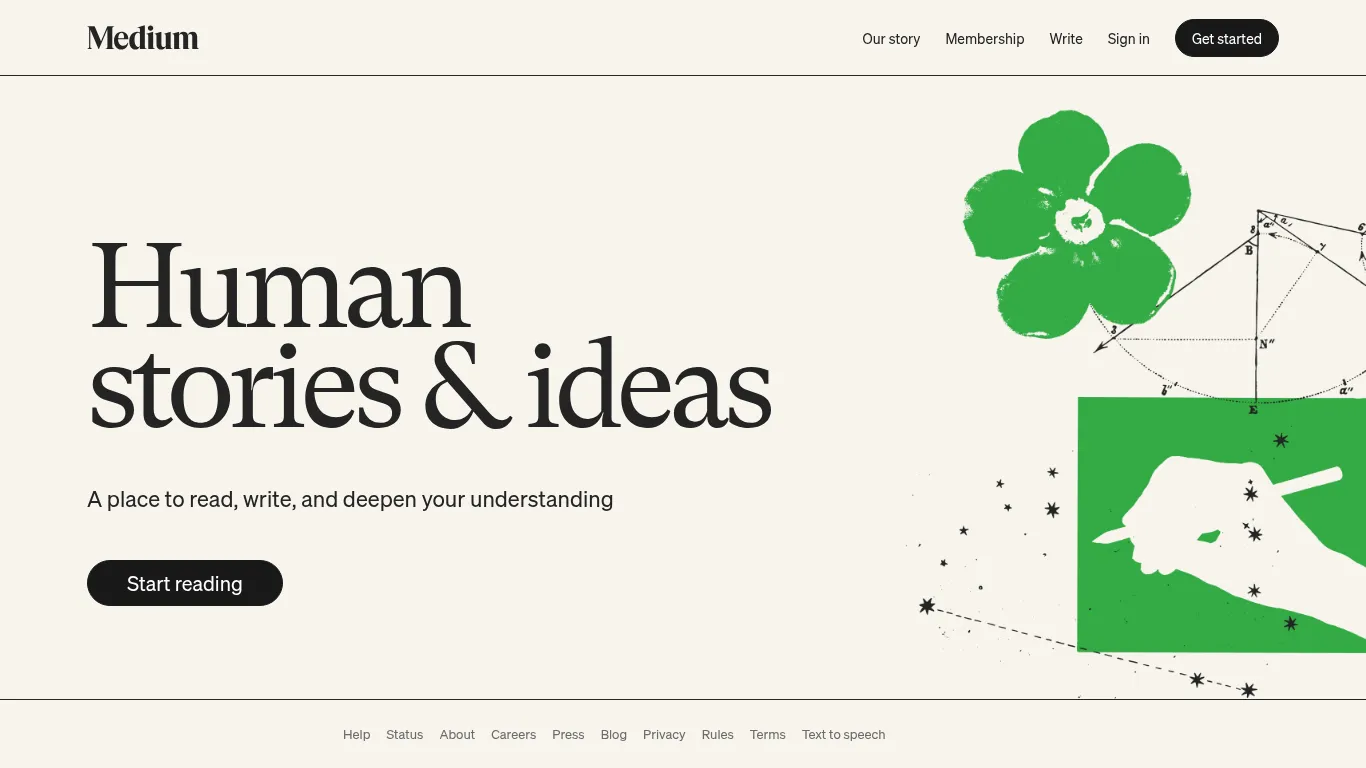
Overview
Publishing platform with network effects and a clean writing experience.
Standout features
Distribution through recommendations/publications; no design or hosting worries.
Where it falls short
Limited brand control; monetization depends on the platform’s rules and algorithms.
Best for
Thought leadership, essays, and teams prioritizing readership over full ownership.
Quick Specs
Feature | Details |
|---|---|
Hosting model | Fully hosted publishing network |
Setup time | Minutes; publish immediately |
Distribution | Algorithmic recommendations, publications, and followers |
Monetization | Partner Program earnings tied to member reading time |
SEO | Canonicals supported; limited control over site structure |
Design | Minimal; content‑first layouts |
Analytics | In‑platform post and audience stats |
Ideal users | Writers seeking reach without owning full web infrastructure |
Getting started tip
Cross‑post summaries from your main blog; link canonical URLs to protect SEO.
8) HubSpot CMS - Marketing, CRM, and content under one roof
HubSpot CMS connects your blog with forms, CRM, automation, and reporting - so every post can capture leads, personalize experiences, and prove pipeline impact.
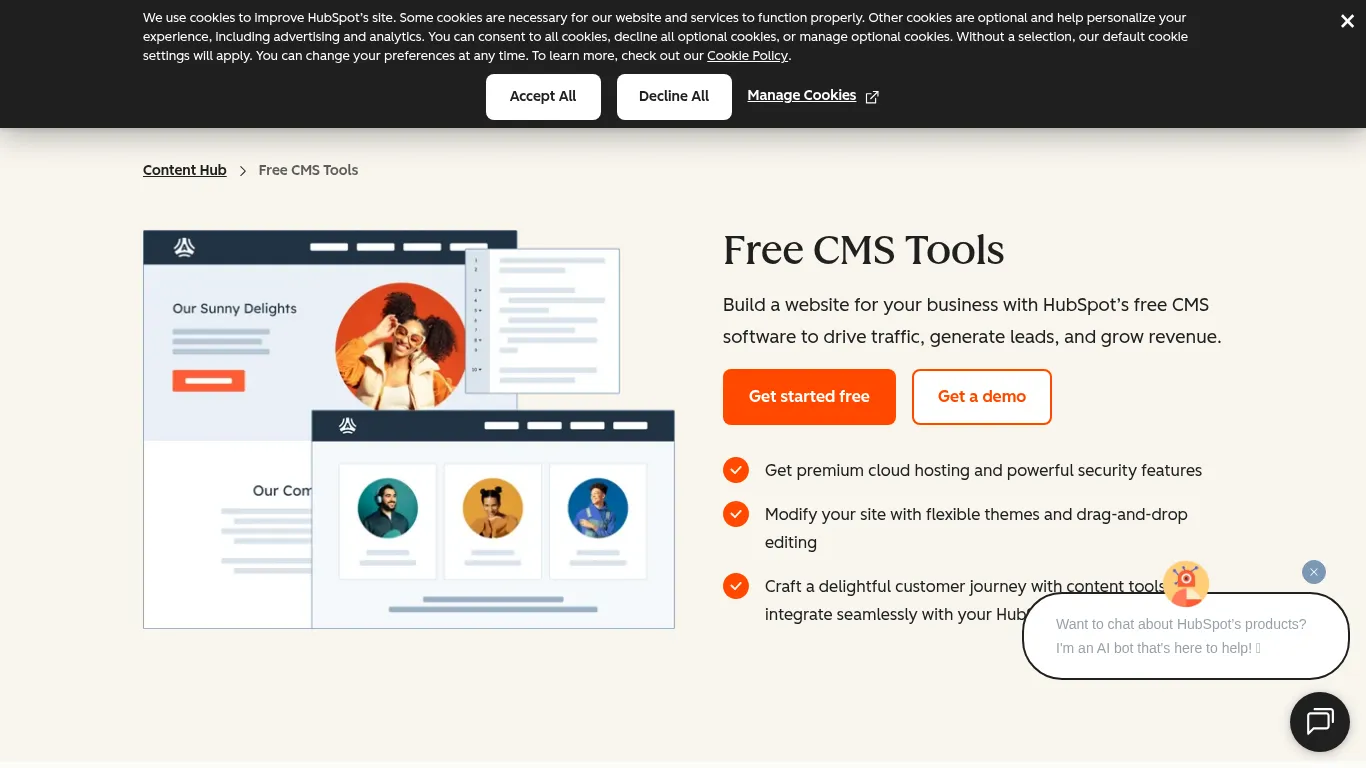
Overview
CMS that ties your blog to forms, CRM, automation, A/B testing, and reporting.
Standout features
Built‑in SEO recommendations, personalization, smart content, and lead capture.
Where it falls short
Can be pricier than basic blog tools; advanced design may need developers/partners.
Best for
B2B SaaS and sales‑led teams aligning content with pipeline and lifecycle nurture.
Quick Specs
Feature | Details |
|---|---|
Hosting model | Fully hosted, enterprise‑grade cloud infrastructure |
Setup time | Quick with theme marketplace and drag‑and‑drop editor |
CRM & forms | Native CRM, forms, CTAs, and list segmentation |
Automation | Workflows, lead scoring, and lifecycle campaigns |
SEO | Built‑in SEO recommendations and topic clusters |
Personalization | Smart content, dynamic CTAs, audience targeting |
A/B testing | Native A/B and experiments on pages/posts |
Analytics | Full‑funnel reporting from visit to revenue |
Integrations | Connects to sales, service, and marketing Hubs; app ecosystem |
Ideal users | B2B teams tying content to pipeline and revenue attribution |
Getting started tip
Map blog categories to lifecycle stages and attach relevant CTAs and workflows.
9) Storyblok - Headless CMS with a visual editor
Storyblok combines an API‑first, component‑based architecture with an in‑context visual editor so marketers can preview changes while developers ship to any front end.
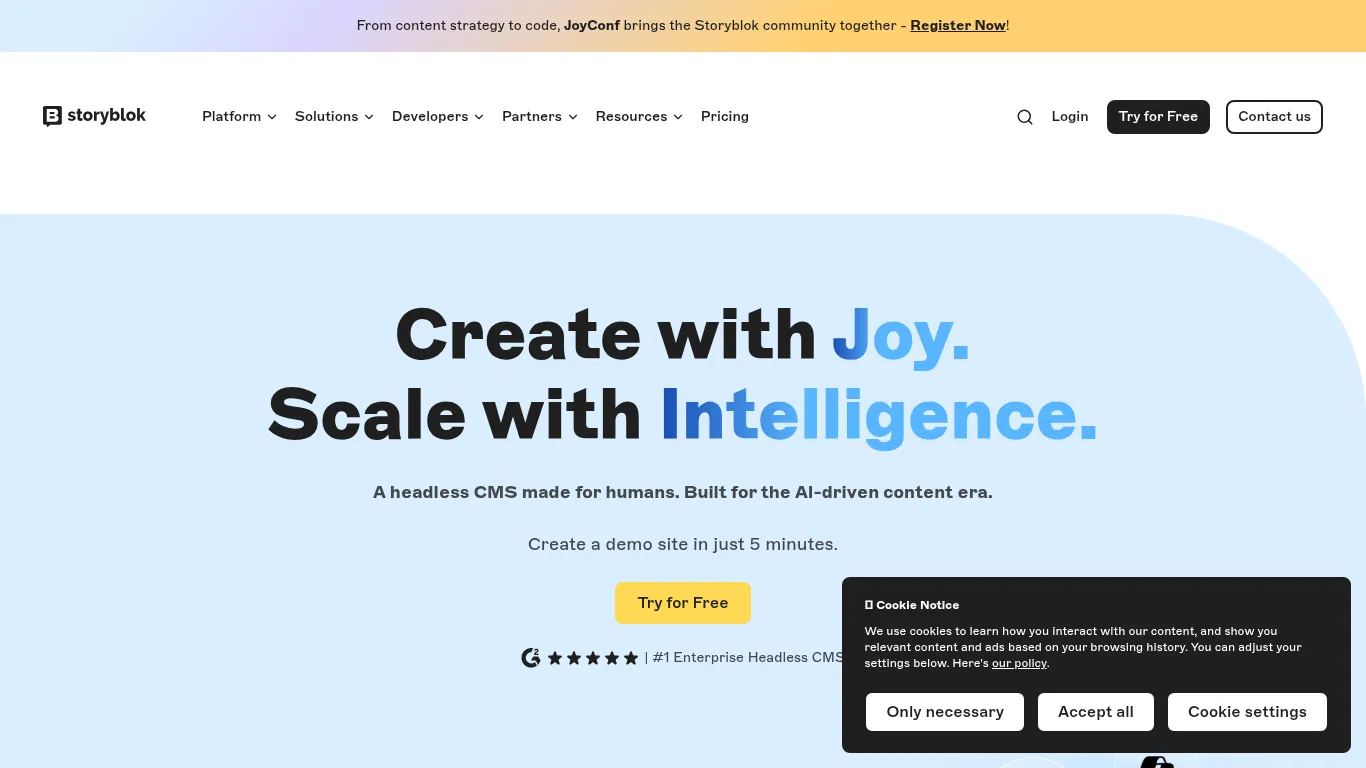
Overview
Component‑based headless CMS that lets editors preview content while developers ship anywhere via APIs.
Standout features
Reusable blocks, roles/workflows, localization, and omnichannel publishing.
Where it falls short
Requires developer setup and a front‑end framework.
Best for
Scaling content teams running multi‑site, multi‑language, or app/web experiences.
Quick Specs
Feature | Details |
|---|---|
Hosting model | Headless CMS (SaaS) with REST/GraphQL and management APIs |
Setup time | Requires front‑end integration (Next.js, Nuxt, Astro, etc.) |
Content model | Component‑based blocks and flexible content types |
Visual editing | Live preview with in‑context editing and collaboration |
Localization | Multi‑language content, translation workflows |
Roles & workflow | Roles, approvals, versioning, and scheduling |
Performance | Decoupled delivery; CDN caching for speed |
Integrations | App ecosystem; Figma‑to‑components, webhooks, custom apps |
Security | ISO 27001; enterprise SLAs and advanced permissions |
Ideal users | Multi‑brand, multi‑region teams needing reusable content at scale |
Getting started tip
Define a modular content model early (post, author, category blocks) to enable reuse.
10) Super - Notion‑to‑site made fast and simple
Super turns Notion pages into fast, styled websites and blogs with custom domains, giving Notion‑first teams a lightweight path to publish without managing a full CMS.
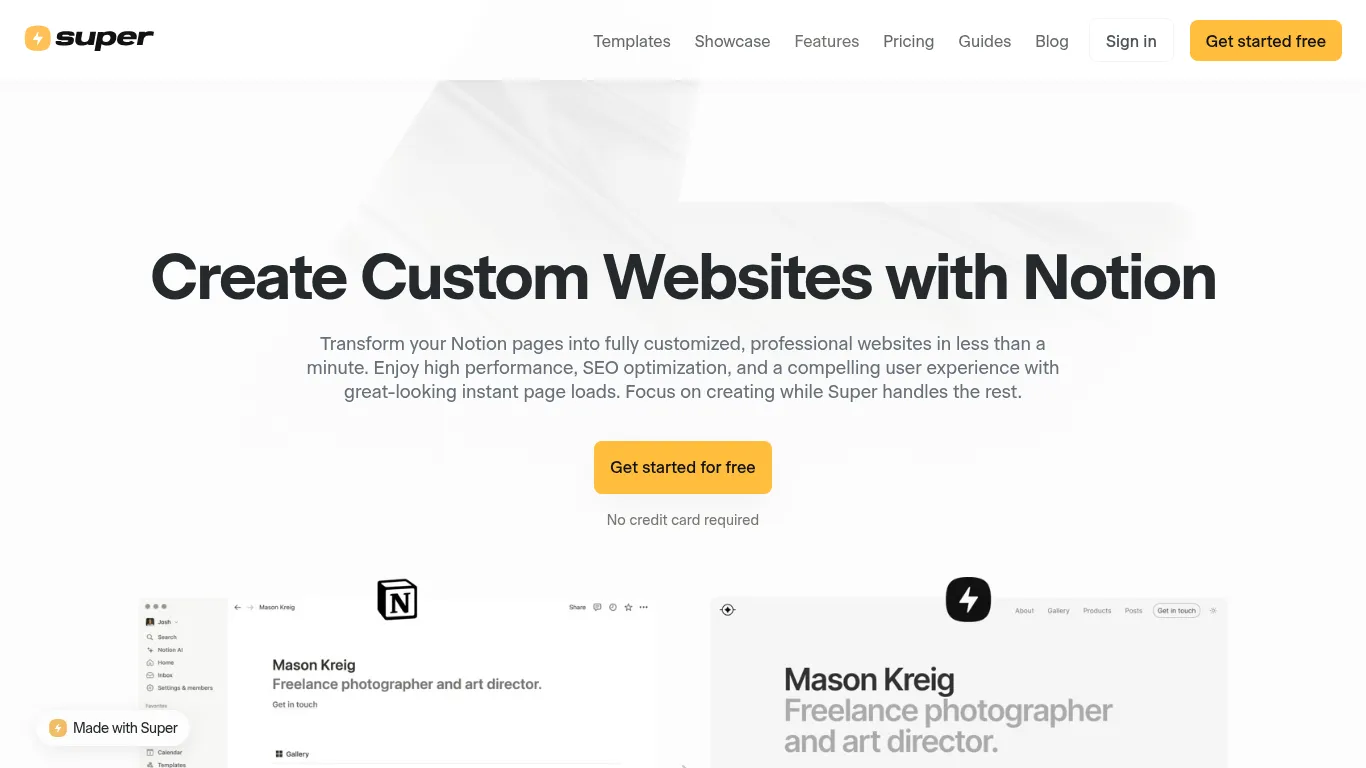
Overview
Turn Notion pages into fast, styled websites and blogs with custom domains.
Standout features
Instant Notion sync, themes, and performance optimizations compared to basic Notion sharing.
Where it falls short
Blogging features are simpler than full CMS; advanced SEO and structures may need workarounds.
Best for
Teams who love Notion and want a lightweight, beautiful blog without a CMS build.
Quick Specs
Feature | Details |
|---|---|
Hosting model | Hosted Notion‑to‑site platform with CDN and SSL |
Setup time | Minutes; paste a Notion share link and go live |
Content source | Content lives in Notion; instant sync to site |
SEO | Clean HTML, social cards, sitemap; some advanced options require workarounds |
Design | No‑code themes and templates; optional custom code |
Performance | Instant page loads with global caching |
Blog basics | RSS/Atom feeds, tags, password protection, multi‑language |
Integrations | Custom code embeds and file uploads; flexible add‑ons |
Ideal users | Notion‑centric teams needing a fast, low‑maintenance site/blog |
Getting started tip
Structure Notion with a Posts database (properties for slug, tags, date) before connecting.
Feather Alternatives at a glance: comparison table
Platform | Hosting model | Customization | Monetization | SEO depth | AI/automation | Learning curve |
|---|---|---|---|---|---|---|
BlogBowl | Fully hosted SaaS | No‑code theme controls; limited code‑level edits | Integrated newsletter; supports affiliates/ads embeds; CTAs | Advanced; SEO‑first templates, internal linking, LLM‑ready | Extensive (daily AI posts, keyword research, internal linking) | Low |
Ghost | Hosted (Pro) or self‑hosted | Theme edits, custom routes; deeper changes need dev | Native memberships, paid subscriptions, newsletters | Strong; clean themes, metadata/canonicals | Light (via integrations); native workflows | Medium (higher if self‑hosted) |
WordPress.org | Self‑hosted CMS | Unlimited code‑level control; 60k+ plugins | Ads, affiliates, memberships, ecommerce | Very advanced; full schema, redirects, sitemaps | Optional via plugins (writers, images, SEO) | Medium–High |
Webflow CMS | Fully hosted with CDN | Pixel‑perfect visual designer; components | Ecommerce, memberships, gated content | Advanced; clean HTML/CSS, custom meta, fast hosting | Moderate (personalization, A/B, growing AI) | High |
Wix | Fully hosted builder | Drag‑and‑drop editor; optional Velo code | Subscriptions, paywalls, ecommerce, ads integrations | Good; AI SEO assistant, instant indexing | Strong (AI site builder, copy, images, emails) | Low |
Squarespace | Fully hosted all‑in‑one | Premium templates; CSS/custom code blocks | Commerce add‑ons, memberships, simple paywalls | Moderate; per‑post meta, basics | Light–Moderate (AI templates/tools) | Low |
Medium | Fully hosted publishing network | Minimal; content‑first layouts | Partner Program earnings; limited controls | Limited; canonicals supported | None (algorithmic distribution only) | Very Low |
HubSpot CMS | Fully hosted enterprise cloud | Themes/modules; dev‑friendly for custom | Lead capture, gated content, CRM‑driven nurture | Advanced; SEO recommendations, topic clusters | Strong (automation, smart content, AI assists) | Medium |
Storyblok | Headless CMS (SaaS) | Component schema; front‑end freedom via APIs | Flexible (front‑end dependent: paywalls, ecommerce, etc.) | Advanced (front‑end dependent; CDN delivery) | Moderate (AI translations, labs) | High (dev setup required) |
Super | Hosted Notion‑to‑site | No‑code themes; optional custom code | Basic (embeds, links; limited native options) | Moderate; optimized HTML, social cards | Minimal | Low |
Final thoughts: Pick the platform that fits your growth motion
If you want hands‑off growth and SEO at scale: start with BlogBowl.
If you want full control and an ecosystem: WordPress.org or Webflow CMS.
If you’re audience‑first: Medium (cross‑post from your main blog).
If you’re scaling multi‑site/multi‑language: go headless with Storyblok.
If you’re Notion‑native: Super makes it effortless.
Call to action: Launch your SEO‑ready blog in minutes with BlogBowl and let AI handle the heavy lifting while you focus on your product and audience.


